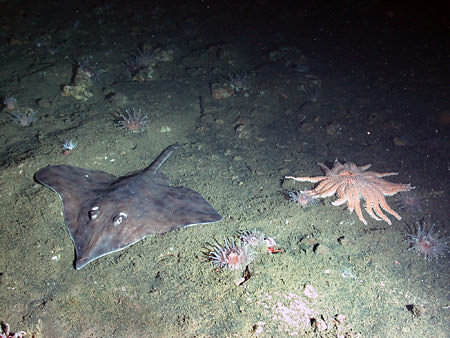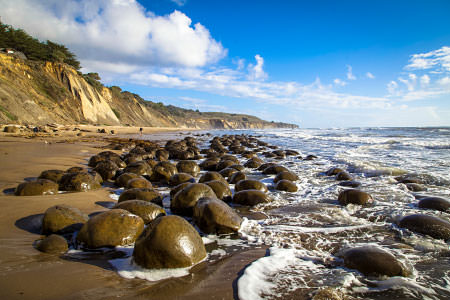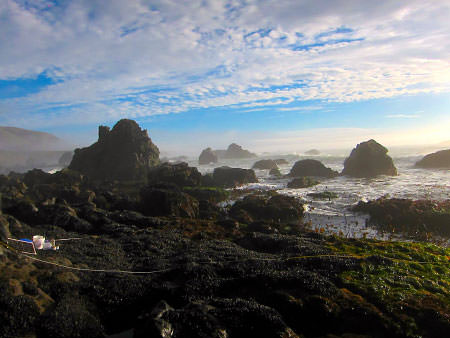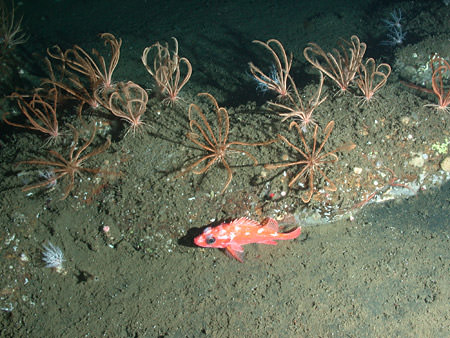From NOAA: For immediate release, March 12
Cordell Bank and Gulf of the Farallones national marine sanctuaries off northern California will both more than double in size following a final rule released today by NOAA. The expansion will help to protect the region’s marine and coastal habitats, biological resources and special ecological features.
Cordell Bank National Marine Sanctuary, located 42 miles north of San Francisco, will expand from 529 square miles to 1,286 square miles. Gulf of the Farallones National Marine Sanctuary will expand from 1,282 square miles to 3,295 square miles of ocean and coastal waters.
“We are thrilled to announce the expansion of two of our sanctuaries in California,” said Holly Bamford, Ph.D., acting assistant secretary of conservation and management and NOAA’s deputy administrator. “It’s important to conserve these special places that encourage partnerships in science, education, technology, management and community.”
The expansion is based on years of public comment and research by NOAA and its scientific partners that identified the nutrient-rich upwelling zone originating off Point Arena and flowing south into the original sanctuaries as one of the most productive in North America.
Cordell Bank and Gulf of Farallones national marine sanctuaries represent globally significant, extraordinarily diverse, and productive marine ecosystems that encompass areas as varied as estuarine wetlands, rocky intertidal habitat, open ocean and shallow marine banks. They include areas of major upwelling where nutrients come to the surface and support a vast array of sea life including 25 endangered or threatened species, 36 marine mammal species, including blue, gray and humpback whales, harbor seals, elephant seals, Pacific white-sided dolphins, and one of the southernmost U.S. populations of Steller sea lions; over a quarter million breeding seabirds; and one of the most significant white shark populations on the planet.
In Republicans’ ‘War On Nature,’ California Gets A Big Win
The Obama Administration has announced plans to nearly triple the size of two major marine sanctuaries off the coast of Northern California. After more than a decade of public comment and research by the National Oceanic and Atmospheric Administration (NOAA), Cordell Bank National Marine Sanctuary will expand from 529 square miles to 1,286 square miles and the Gulf of the Farallones National Marine Sanctuary will expand from 1,282 square miles to 3,295 square miles. Together, the two sanctuaries will be nearly the size of Connecticut. When combined with the nearby Monterey Bay National Marine Sanctuary, a a stretch of more than 150 miles of coastal waters will now be protected. […]
Described as the “blue Serengeti” by scientists for their nutrient-rich areas, the sanctuaries support a diverse array of marine life, including 25 endangered or threatened species, 36 marine mammals, and more than a quarter million breeding seabirds, the largest colony of seabirds in the U.S. While the broadening of these wildlife havens had near unanimous local support in the Bay Area, previous attempts in Congress to pass their expansion had failed due to oil and gas industry opposition. Extending north of San Francisco’s iconic Golden Gate Bridge, the sanctuaries will now be permanently off-limits to drilling.
Richard Charter, a senior fellow with the nonprofit Ocean Foundation, called the development a miracle.
Senator Barbara Boxer (D-CA) has been working to get these protections in place for a number of years and here office issued this statement:
Washington, D.C. – U.S. Senator Barbara Boxer (D-CA) today praised the National Oceanic and Atmospheric Administration’s (NOAA) final rule to expand the Gulf of the Farallones and Cordell Bank National Marine Sanctuaries, which would more than double the size of the sanctuaries and permanently protect the entire Sonoma County coastline and part of the Mendocino County coastline to just south of Alder Creek.
Senator Boxer said, “I am grateful to the Obama Administration for this historic decision, which will more than double these magnificent national marine sanctuaries off the California coast and permanently protect one of the most productive coastal ocean regions on the planet.”
Senator Boxer and former Congresswoman Lynn Woolsey (D-Petaluma) were the chief sponsors of legislation to expand the sanctuaries and urged the Administration to use its authority to permanently protect the area.
Senator Boxer and Congresswoman Woolsey joined NOAA officials when the proposed expansionwas first announced in December 2012. After a process lasting more than two years that included public comment and research by NOAA and its scientific partners, the rule will go into effect after a review period.
The expansion will help support the more than half a million jobs and over $34 billion in economic activity that depend on ocean tourism, recreation, and fishing in California. It will also permanently protect important habitat for at least 25 threatened or endangered species, including magnificent blue whales, humpback whales, northern fur seals and leatherback turtles – California’s official marine reptile; spectacular living reefs of corals and sponges; one-third of the world’s whale and dolphin species; at least 163 bird species, including the largest colony of seabirds in the continental U.S.; and more than 300 species of fish, including commercially valuable salmon and groundfish.
Images from NOAA: NOAA expands Cordell Bank and Gulf of the Farallones national marine sanctuaries off northern California (used by permission, more photos at the link)

Deep sea habitats in Bodega Canyon, part of the expanded Cordell Bank National Marine Sanctuary provide unique habitat to long nose skate, sunflower stars and more. Credit: CBNMS/NOAA

Unique geologic formations along the coast provide different textures and habitats for wildlife. Credit: Matt McIntosh/NOAA

Shell Beach in Sonoma is one of the new intertidal monitoring sites LiMPETS program middle and high school will be studying in the expansion area. Credit: Monika Krach/Farallones Marine Sanctuary Association (FMSA)

The deep water habitats in the expanded Cordell Bank National Marine Sanctuary harbor deep sea invertebrates and fishes such as these crinoids, sea cucumbers and rosethorn rockfish.
Credit: CBNMS/NOAA

5 comments